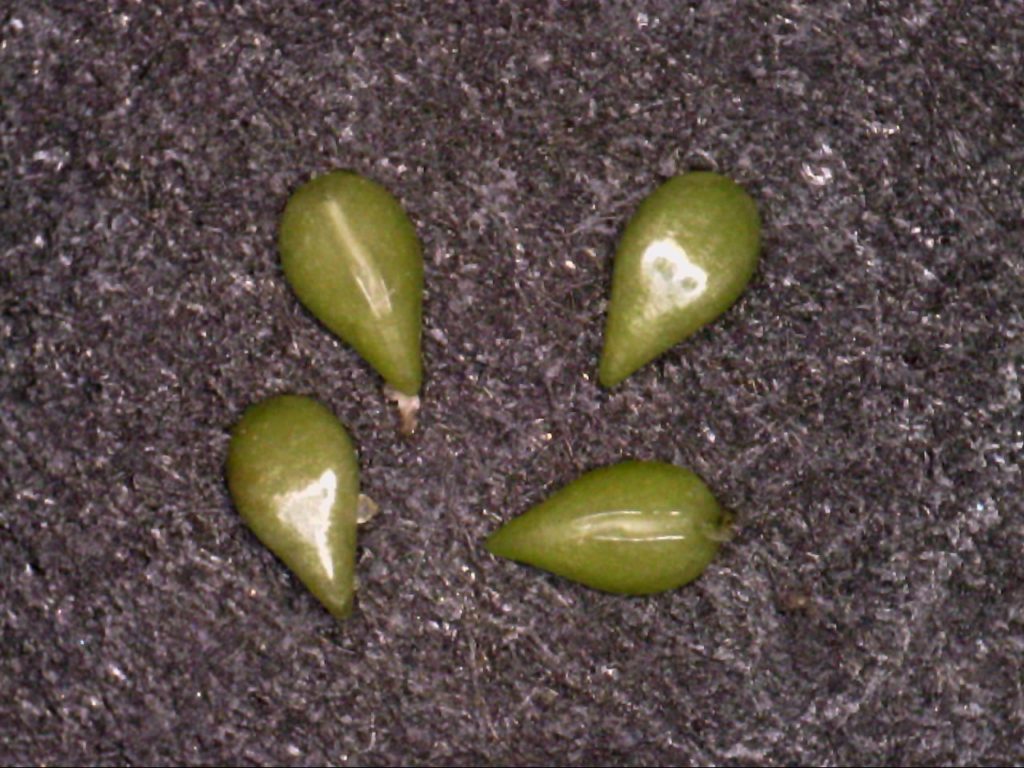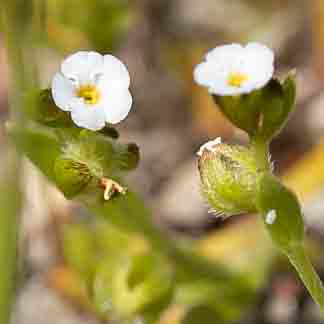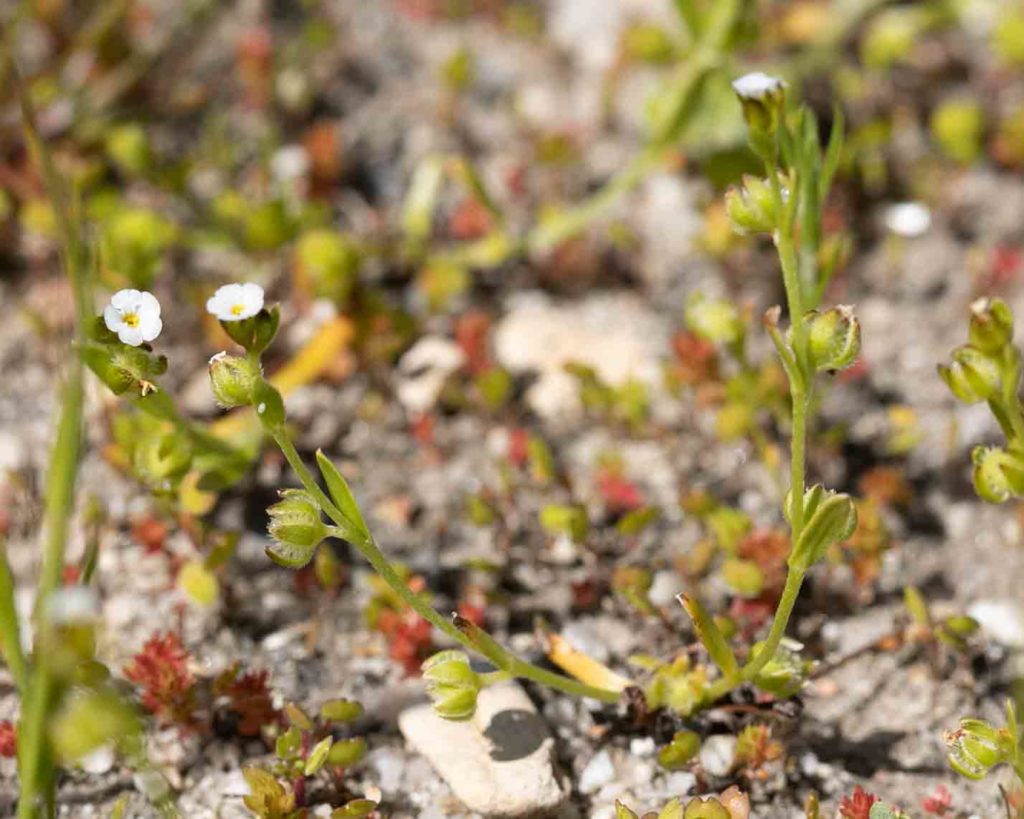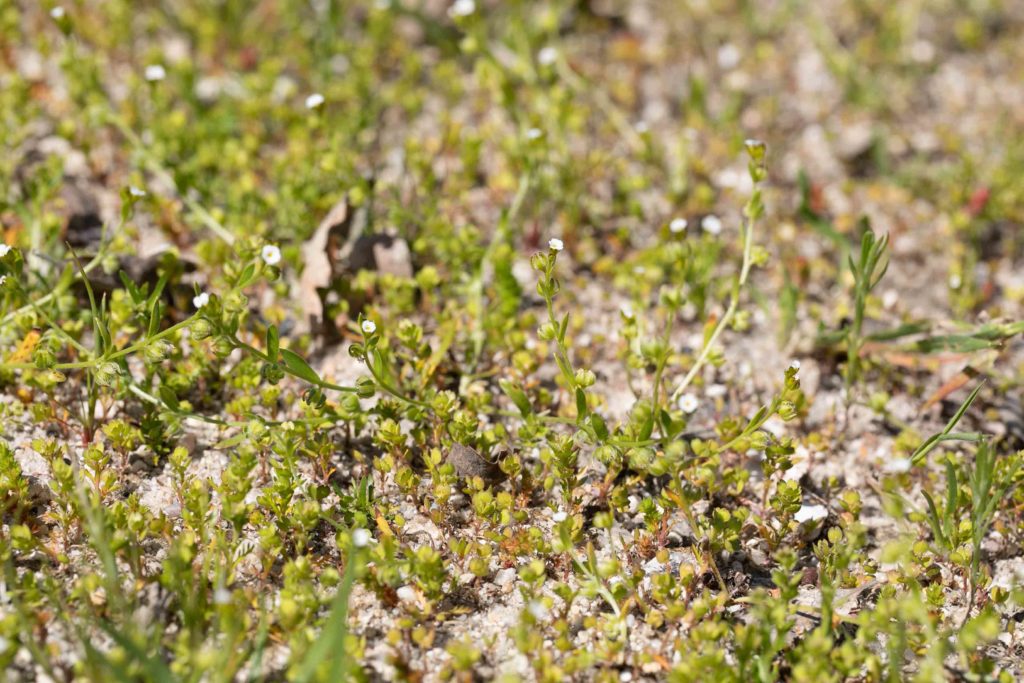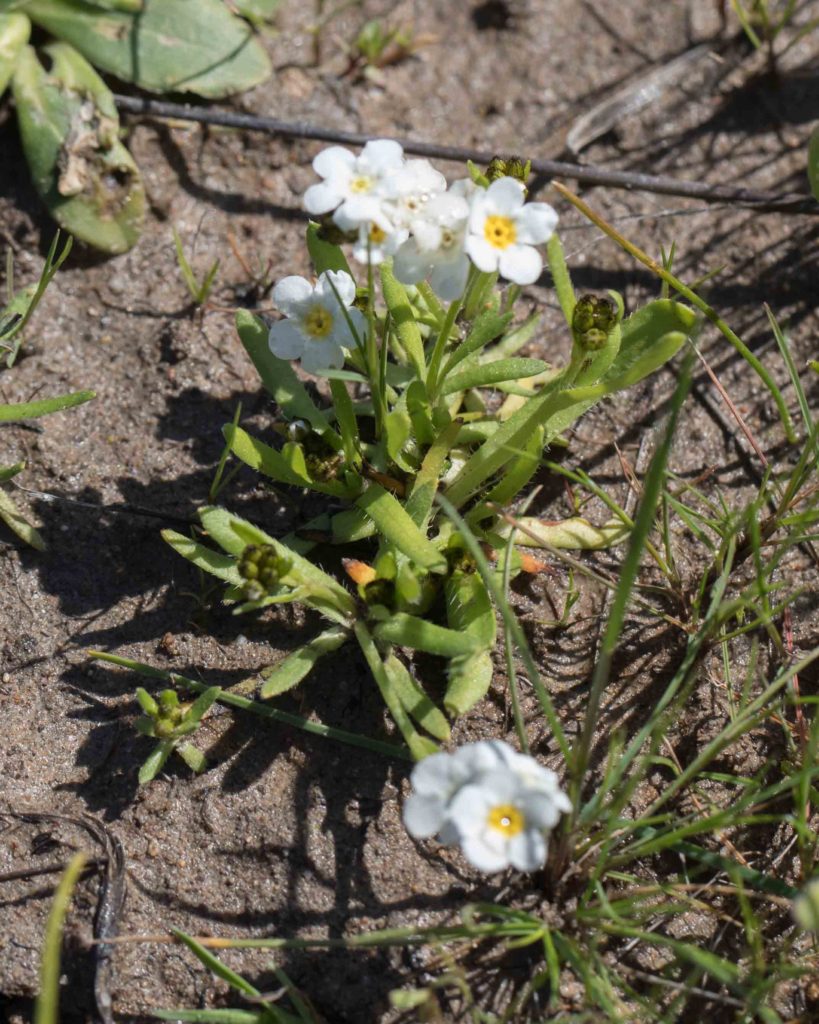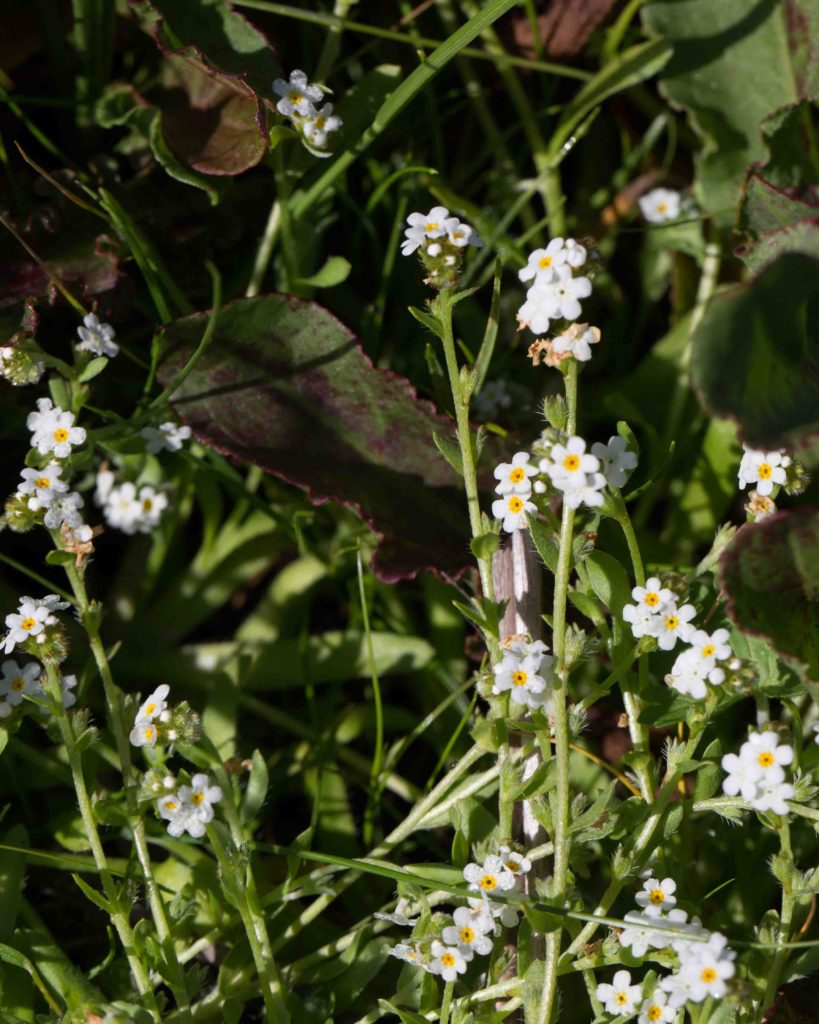Boraginaceae: Borage Family — Popcornflowers
Most members of the Borage family have their flowers arranged in coiled (scorpiod) cymes. They bloom from the base upwards, gradually unfurling like a scorpion’s tail or caterpillar, as new flowers emerge.
Popcornflowers are extremely challenging to identify in the field. All of them have similar white flowers, varying only in size and in the appearance and color of the “appendages”. These are located at the base of the corolla lobes, and are sometimes yellow, sometimes white and occasionally absent. Do not rely too heavily on the appendage color, as this can often vary on the same plant, or even the same flower head. The growth habits, size and hairiness of the plants cover a wide range, so it’s hard to use these as for identification.
The key distinguishing characteristic is to be found in the nutlets. First, the distinction between Cryptantha and Plagiobothrys is that the inner surface of Cryptantha nutlets has a distinct longitudinal groove. Plagiobothrys nutlets lack this groove, but instead have a distinct attachment scar below the middle of the inner surface.
Second, especially within the Cryptantha, count the nutlets (between 1 and 4), decide whether they are rough or smooth, and then examine their individual shapes. The problem is that the nutlets are all small, sometimes very small, and it is hard to come to any conclusions without a microscope.
With Plagiobothrys, one can narrow the choices by seeing whether a plant has any opposite leaves. One of the most common, Rusty Popcornflower (P. nothofulvus) has another unusual characteristic — the calyx is circumscissile in fruit, meaning that the top separates from the base like a lid. Nutlets are generally 4 in number, variable in their shape and appearance.
Enjoy these pretty little flowers, but be warned that you will need a proper botanical key, a microscope, and a good deal of practice to identify individual species with confidence. This page illustrates a small number of species, more to show some of the variations than to act as a guide to identification. The fingernail is included in some of the photos for scale; it is exactly 1 cm across at its widest point.
Coastal Cryptantha – Cryptantha clevelandii var. florosa
Blooms:
Mar–June
Plant Height:
10–60 cm
Flower Size:
Small
Origin:
Native
Habitat:
Sandy or rocky soils, chaparral, coastal scrub
Notes:
This plant is common near the coast. Flowers are 2–5 mm across, the calyx has straight bristles, and the spikes are in 2s and 3s. In contrast, variety clevelandii (see below), also found near the coast, has spikes in 1s or 2s. The calyx is not appressed to the stem in fruit. There are 3–4 smooth nutlets.
Minute-flowered Cryptantha – Cryptantha micromeres
Blooms:
Mar–July
Plant Height:
5–50 cm
Flower Size:
Very small
Origin:
Native
Habitat:
Gravelly or rocky open slopes
Notes:
One of the few cryptanthas which stands a chance of being identified by its appearance. Its flowers are seriously tiny, no more than 1 mm across. To be certain of the identification, one would need to examine the fruits. Each small fruit contains 4 nutlets, one of which is slightly larger and smoother than the others. A good microscope or exceptional eyesight is required to discern this.
Tejon Cryptantha – Cryptantha microstachys
Blooms:
Apr–June
Plant Height:
10–50 cm
Flower Size:
Very small
Origin:
Native
Habitat:
Dry openings
Notes:
Seriously small flowers (1–3 mm across), but not quite as tiny as those of the Minute-flowered Cryptantha (Cryptantha micromeres, see above). The calyx has noticeably bristly, spreading hairs. It has just one nutlet, and that is symmetrical.
Showy Prickly-nut Cryptantha – Cryptantha muricata var. muricata
Blooms:
Mar–June
Plant Height:
10–60 cm
Flower Size:
Very small
Origin:
Native
Habitat:
Gravelly or rocky open slopes
Notes:
The nutlets of this species are easier than some to identify. They are 3–4 in number, and lance to triangular-ovate in shape, with fine to coarse, sharp bumps. The plant is stout, and gray-green to yellowish-green. Stems are ascending to erect, and hairy. Leaves are < 5 cm long, linear to narrowly oblanceolate. Flowers are 1.5–2.5 mm across. Calyx lobes have rough, bristly hairs.
Dwarf Cryptantha – Cryptantha torreyana var. pumila
Blooms:
Apr–June
Plant Height:
5–20 cm
Flower Size:
Very small
Origin:
Native
Habitat:
Chaparral, foothill woodland
Notes:
Uncommon in Monterey County. A small plant, even by popcornflower standards, this is most easily identified by its 3–4 smooth nutlets. The calyx lobes have noticeably spreading bristles and are much longer than the nutlets. The whole plant is distinctly hairy. Flower spikes are generally in 2s. The corolla limbs are 1–2 mm in diameter.
Northern / Winged Pectocarya – Pectocarya penicillata
Blooms:
Feb–May
Plant Height:
2–25 cm
Flower Size:
Very small
Origin:
Native
Habitat:
Dry sandy or gravelly places
Notes:
Although Pectocarya is not strictly a popcornflower, its flowers are identical, if somewhat smaller than most (< 2.5 mm across). However, this species is easily identified by its distinct fruit, an X-shaped array of 4 straight nutlets, each lined with comb-like, unhooked hairs. In the third photo from the left, the Pectocarya flowers are the smaller ones, the other, larger flowers belong to a popcornflower growing alongside it.
Adobe Popcornflower – Plagiobothrys acanthocarpus
Blooms:
Mar–May
Plant Height:
10–40 cm
Flower Size:
Very small
Origin:
Native
Habitat:
Vernal pools or moist clay soils
Notes:
This is a small plant with very small flowers. It is most easily identified by the slightly fleshy appearance of its young leaves, but more reliably by its prickly nutlet. This has been found in abundance just outside and just inside the main (Jolon Road) entrance of Fort Hunter Liggett, but quickly disappears as the soil dries out.
Hickman’s Popcornflower – Plagiobothrys chorisianus var. hickmanii
Blooms:
Apr–July
Plant Height:
Prostrate (< 40 cm)
Flower Size:
Small
Origin:
Native
Rare or Endangered?
Yes – 4.2
Habitat:
Vernal pools
Notes:
This has comparatively showy flowers (5–7 mm across) for a popcornflower, not unlike those of the Stalked Popcornflower (Plagiobothrys stipitatus var. micranthus, see below), which is also found in vernal pools and moist grassy places. However, its leaves are smooth and without a thickened midvein. The nutlet attachment is lateral or obliquely basal, and lacks the short peg found in the Stalked Popcornflower. Found around the Monterey Peninsula and in Fort Ord, where it may be seen in large numbers alongside the even rarer Contra Costa Goldfields (Lasthenia conjugens).
Rusty Popcornflower – Plagiobothrys nothofulvus
Blooms:
Mar–May
Plant Height:
20–70 cm
Flower Size:
Small
Origin:
Native
Habitat:
Grassland
Notes:
One of the most common popcornflowers on the Monterey Peninsula, found in profusion in open grassland. Leaves are mostly basal with some alternate cauline leaves. Flowers are pure white, 4–9 mm across. The appendages in the center of the flowers may be white or yellow. The common name derives from the rusty-colored calyx which, unusually, is “circumscissile” so that the top separates from the base like a lid.
Stalked Popcornflower – Plagiobothrys stipitatus var. micranthus
Blooms:
Apr–July
Plant Height:
10–40 cm
Flower Size:
Small
Origin:
Native
Habitat:
Vernal pools
Notes:
This has comparatively showy flowers (5–12 mm across), similar to the rare Hickman’s Popcornflower (Plagiobothrys chorisianus var. hickmanii, see above), which is also found in vernal pools and moist grassy places. It can be identified by the blister-based hairs on its leaves, and by the nutlets which are on short pegs (hence the plant’s common name). Neither of these features is found in Hickman’s Popcornflower.

















